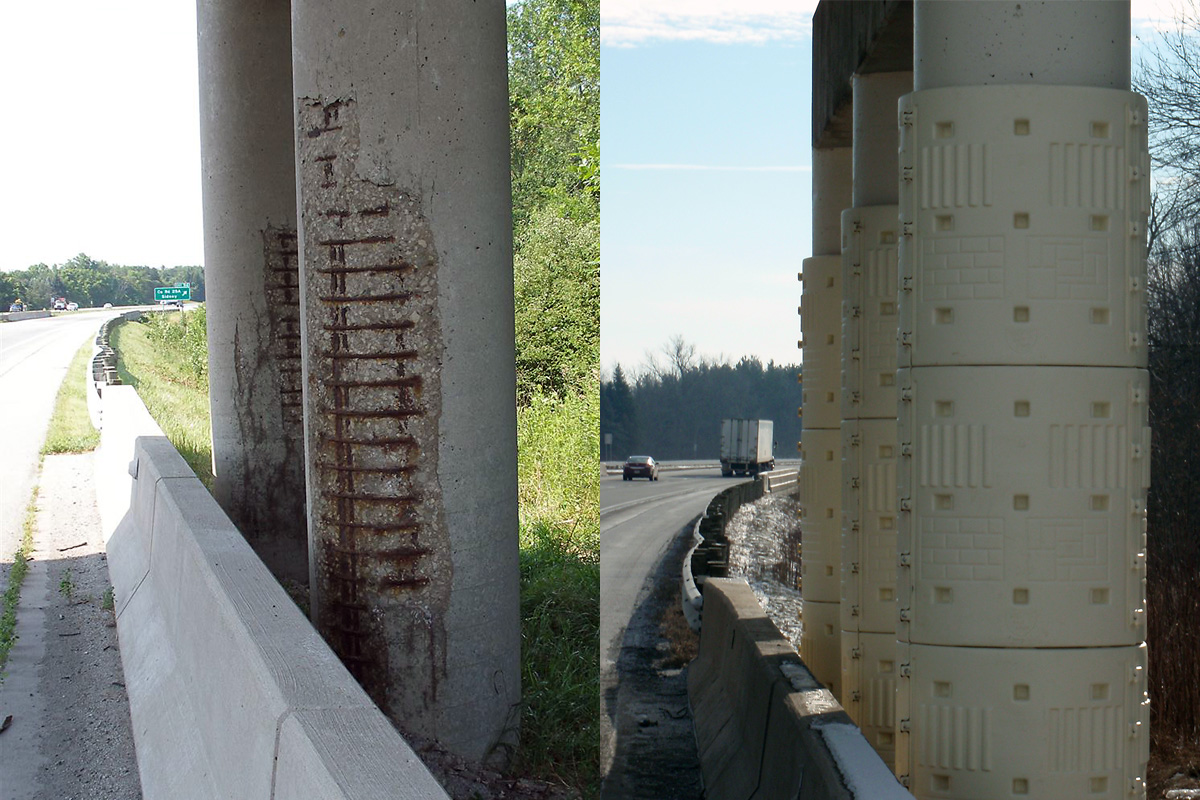
States Innovate!
Ohio Shields Bridge Piers from Corrosion
The Ohio Department of Transportation (ODOT) is using a new product to protect concrete bridge pier columns from the salt-laden snow thrown on them during normal snow plowing operations. When road salt and grit hit the piers, chlorides from the salt can penetrate the concrete surface, causing deterioration and spalling to occur at a much faster rate. Rain does not wash the salt off completely because columns are protected by the concrete deck of the overhead structure. Years of this saturation and abuse from winter operations take their toll on concrete pier columns.

ODOT is employing a polyethylene product that wraps around concrete pier columns to prevent chloride penetration and corrosion.
Credit: Ohio Department of TransportationODOT has tried applying protective coatings on some piers but found that over time the coatings can peel or wear away. In 2013, ODOT began testing a new polyethylene product that wraps around concrete pier columns to prevent chloride penetration and corrosion. ODOT’s observations so far are that the protected pier concrete has not experienced accelerated deterioration as compared to the unprotected concrete used as a control.
In addition, a recently completed research project that compared use of the polyethylene product to traditional coatings found that it was easy to install in about 30 minutes with a three-person crew. Read ODOT’s research project fact sheet for more details.
ATSPMs Improve Traffic Management in Dover, New Hampshire
In partnership with FHWA and the New Hampshire Department of Transportation, the city of Dover, NH, installed Automated Traffic Signal Performance Measures (ATSPMs) at 17 intersections within its Central Avenue corridor to coordinate traffic signals and improve traffic flow.
Traffic signals at these intersections are now connected wirelessly to the city’s central traffic server that consistently monitors traffic flow within the system and notifies staff when an issue arises along the corridor. The technology also provides the ability to make real-time traffic signal programming changes within the system based on current conditions. The result is an informed approach to developing signal timing that is not dependent on limited, expensive manually collected data sets and citizen calls to gain insight on how the system is working.
The city of Dover saw this effort as an opportunity to make a dramatic change from the traditional approach to managing its signal system. By implementing ATSPMs, the city is able to get a complete data set to help better understand the needs of the vehicles, pedestrians, and bicycles using the network. Dover produced a video describing the project in more detail.
A grant from FHWA’s Accelerated Innovation Deployment (AID) Demonstration Program helped make this project possible. The program provides funding to accelerate the implementation and adoption of innovation in highway transportation.
Recommended Citation: U.S. Department of Transportation, Federal Highway Administration - Washington, DC (2021) Innovator Newsletter, September/October 2021, Volume 15(86). https://doi.org/10.21949/1521364



